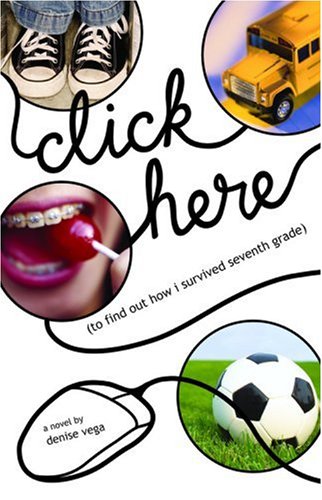by Annemarie McDaniel
Growing up, I had always been plugged into the computer. I still love the baby photo of me where I’m hunched over my giant desktop  screen before age 5, playing some educational CD-ROM game. I loved computers from a very young age, but I didn’t realize how much I creative I could be through them until I read the young adult fiction novel, Click Here: (To Find Out How I Survived Seventh Grade) by Denise Vega.
screen before age 5, playing some educational CD-ROM game. I loved computers from a very young age, but I didn’t realize how much I creative I could be through them until I read the young adult fiction novel, Click Here: (To Find Out How I Survived Seventh Grade) by Denise Vega.
Click Here is the story of 7th grader Erin Swift, who is learning how to balance friendship, romance, and bullies during her first year in middle school. Instead of writing in a diary to vent her thoughts and emotions about the daily pre-teen drama in her life, Erin codes her own private blog and uploads daily blog posts about her experiences in school. Erin’s mother is a professional web designer, and after teaching her daughter the basics, Erin decides to code for the school’s Intranet Club, building an internal website to launch over Thanksgiving break. Things go astray though when her Interact and private blog CD-ROMS are switched, and suddenly her personal website-journal becomes publicized to the whole school, and Erin learns the hard way how to mend broken friendships and hurt feelings.
When I read Click Here, I was at the same stage of my life as the protagonist: just entering middle school and finding myself lost as an old friend faded and new bullies emerged. It was the first moment I had ever heard of computer coding. I didn’t think of coding as a “boy” or “girl” hobby, because I didn’t know any other coders at the time. I hadn’t learned the gender gap in STEM yet; to me, it just felt like I was being a hipster, taking the geeky track no one else went down. I loved the idea of building my own digital universe. Eventually, I found the first outlet for my website design: Neopets. Neopets (throwback!) is a website where preteens could adopt imaginary pets called “Neopets,” play puzzles or games, make friends in the forums, and even create mini websites or “guilds” as they called them. After reading Click Here and seeing artistic guild layouts online, I set out to learn how to work Adobe Photoshop and code HTML/CSS. I still remember the first time I messaged someone about how to create the graphic they used on their profile; they emailed me back with a copy of their code and link to learning more.
I also started my own blog, in which I wrote down my own thoughts on middle school, just like Erin. I learned a similar hard lesson as her too. I kept mine not private so I could talk to other pre-teen book lovers, and my blog ended up being discovered by two friends. They then created their own account under a fake name, and created this perfect person for me to befriend, who had everything I ever wanted in life. It was my fault it ever happened, I might’ve shown my blog to my friends once, and looking back, I wrote as such a know-it-all, thinking I was better than others. It worked out fine in the end; I didn’t find out until many years later when we could all just laugh at our middle school selves. And honestly, despite that first bad blog, I’m so glad I started it. Once I began writing online, I couldn’t stop, and created a private writing account on Writing.Com, in which I wrote short stories, poems, novel drafts, and yes, blogs, about my middle school experiences.
It’s weird for me to look back now and think about how the book so greatly shaped my life, since two career paths I love, the digital arts and writing, stemmed from a single character. I get paid to do both now, I work at my college as a graphic designer and coder, and I write for non-profit blogs like SPARK. But even looking beyond Erin’s awesome computer skills, she served as a friend for me. We were both struggling through that first year of middle school, going through bullies (Erin gets called “Pinocchio” and students play puppet-themed practical jokes on her) and heartbreaks and lost friends. It’s comforting to read how you’re not alone and know that it has a happy ending. Erin is not necessarily a perfect role model; she makes mistake after mistake throughout the novel. But that’s the great thing about Erin, she feels relatable because of her flaws, and her personal growth almost feels like your personal growth.
Click Here is a throwback, to be sure (published in 2005), but despite the story’s technology being a little out of date, the characters’ successes and struggles are timeless.
